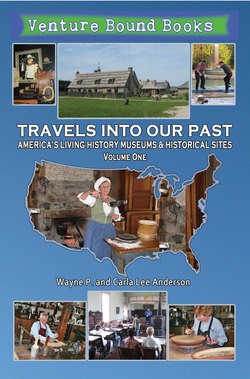Читать книгу Travels Into Our Past: America's Living History Museums & Historical Sites - Wayne P. Anderson - Страница 6
Future living history museums
ОглавлениеA method still only occasionally used, but with great potential is the hologram or holograph. At the Galena County History Museum in a waiting room with the lights turned off, holographs of Grant and his wife welcomed us and told us about their lives in Galena, Illinois. Seeing life-size holographs is still a mindblowing experience for us because the people are standing right in front of us, more real than figures in 3D.
One of our “wow” experiences came the first time when we watched “Ghosts of Lincoln” at the Lincoln Presidential Museum in Springfield, Illinois. We should have guessed something unusual was about to happen since a glass wall stood between the audience and the historian introducing us to the library. He said he would explain the ways in which historical material is collected and analyzed. During the presentation, smoke would appear and slowly take the form of Lincoln or others.
All of this did not prepare us for the final act when a wind began to blow a flag on the stage. The historian stepped to a coat rack, put on a Union army jacket and began to tell us about his experiences in the War Between the States. The solid-looking library became a battlefield scene. As the historian continued to talk, his body slowly disappeared, and we were left with only his voice. We were utterly surprised as we had assumed he was a real person on the stage.
These large-scale holograms, illuminated with lasers or displayed in a darkened room with carefully directed lighting, are incredible. They use two-dimensional surfaces that show absolutely precise, three-dimensional images of real objects. Visitors don’t even have to wear special glasses to see the images in 3-D.
We understand the use of holographs will become even more prominent as the holograms are formatted to answer audio questions. At a later date they will be so convincing that the whole life story of the individual will be programmed into the hologram so that you can discuss the person’s life with him or her.
We expect that an even deeper experience will be had when visitors sign up for a week’s stay in a living history village where they dress like, eat like and do without modern conveniences to get the real feel of what life was like in the past.
This book is divided into nine sections based on the piece of the past the specific living history museum best relates to. In some cases, particularly those like Savannah or Sacramento where the whole community is involved and covers quite a swath of time, we have placed it in the category that best reflects what visitors will come to see.
1.Pre-colonial America
2.Colonial America: covers the first successful attempts at settlement up to the date of the American Revolution
3.Pre-Civil War America: the period roughly from 1812 until the beginning of the Civil War
4.The Cowboy Era: although the settling of the West is taking place at the same time as the major immigration, the setting and goals are different.
5.The Immigrant Experience: mostly takes place on the Great Plains and in Texas in the latter part of the 19th century
6.American Rural Life: the early 20th century including the depression
7.City Life Develops
8.Mines, Steamboats and Trains, Building America’s Infrastructure
9.The Struggle for Civil Rights
